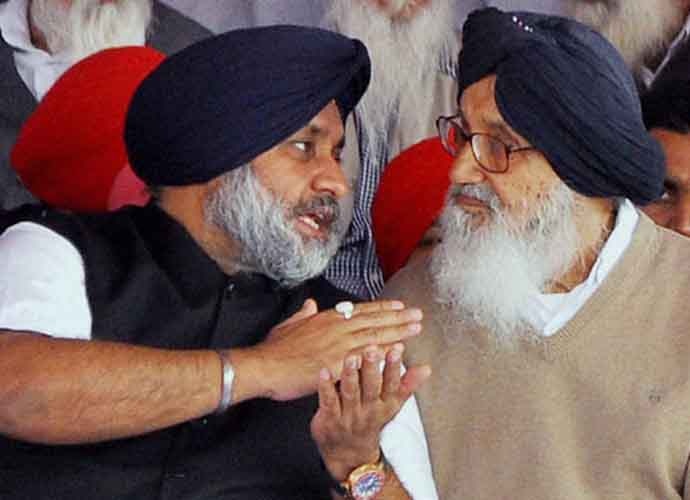How Kejriwal is ending up helping Akalis in Punjab

Campaigning in Punjab has taken an odd turn. Consider this: The state's governing and embattled Shiromani Akali Dal is mercilessly pillorying Arvind Kejriwal and his AAP more than it's attacking the Congress; the Congress under Amarinder Singh has launched its own blitz on the AAP; and rebels in the AAP are also striking the AAP hard.
In Twitter jargon, the election scene in Punjab - a state roiled by drugs, farmers' suicides, corruption and dynast politics - is reduced to what I'd call "Bashtag Kejriwal".
And this probably is good news for chief minister Parkash Singh Badal, his son and daughter-in-law, who till two months ago were at the centre of harsh criticism for their alleged sins of omissions and commissions over their ten-year rule. Moreover, the Badals got some better news recently.
This month, the Supreme Court reinstated the 2011 Shiromani Gurdwara Parbandhak Committee (SGPC) in a move that by default reinforces the family control on the powerful top Sikh religious administration.
Five years ago, the Punjab and Haryana High Court had nullified the SGPC house over issues regarding voting rights to non-practising Sikhs. The top court struck down the 2011 verdict and restored the 170-member committee, a majority of which is the SAD, elected earlier that year.
Indications suggest the Badals are in to retain their stranglehold of the SGPC for another five years, without the need for their party to face religious elections that would otherwise have been due in 2016 itself.
 |
| Punjab CM Parkash Singh Badal and deputy CM Sukhbir Singh Badal. (Photo credit: PTI) |
In state politics too, it would be wishful thinking to imagine a complete rout of the SAD in the Assembly vote early next year.
Here's the basic mathematics that supports the notion that the Akalis may be down but not out. Of all the 117 constituencies of the state, between 50 and 60 are identified as typically Sikh boroughs. These seats are the core strength of the SAD.
If their worst performance in recent history is any pointer, the Akalis have been able to secure at least 40 seats on their own.
Their BJP allies stand on 23 seats separately. Campaigning has changed rapidly in Punjab over the past two months.
It has deflected a lot of focus from the incumbents - who are accused of wrecking the state in more than one way, charges they deny - to Kejriwal and his AAP.
In his electioneering, Delhi's maverick CM matches the Badals in evoking what can be termed "victimhood", his own and that of his audiences, real or supposed.
For example, his Sunday speech to the Hindu traders, a traditional constituency of the BJP, has become the talk of the town in the state.
The AAP leader hit a soft spot in his Jalandhar address when he promised to end what he called "raid raj" on small businesses if voted to power.
As of now, Kejriwal is still reaping the harvest in Punjab of his attacks on crony capitalism he mounted in Delhi before his re-election.
Again, that's something which strikes the chord with ordinary voters, who feel heavily marginalised in India's growth story.
In almost every event in Punjab, he is hooted by the Akali and Congress workers alike. Let's talk about the Akalis again here.
The SAD, even if it loses power next year, is unlikely to go politically bankrupt, given its conservative base among farmers and Sikh boroughs in the interiors of Punjab and their hold over the SGPC.
The Kejriwal factor, and the way it has evolved in the state till now, has come as manna from heaven for the ruling party. The cacophony it has been able to generate, largely stemming from negative publicity, has left the voters confused. Mind you, negative campaigns work both ways.
On the one hand, they help the electorate stay informed. On the other, they may also stoke favourable emotions for candidates under fire.
Ostensibly, Kejriwal is garnering public attention outside of Delhi because voters sometimes tend to explore the ridiculed. The AAP founder is a leader in a hurry, though. Beneath all the chaos around him, he appears to be exhausting his energy rapidly.
As of now, he hasn't lost all the ground in Punjab to strong head winds. But by inadvertent courtesy of him, the Akalis appear to have been able to arrest theirs from slipping further.
At the end of the day, elections are all about transfer of votes from the incumbents to the opponents.
If the opposition vote is divided, it's a win-win proposition for the government. But let's not write off Amarinder Singh so soon.
He is seen as a pro-Punjab face. His track record shows he opposed someone as powerful as Indira Gandhi at a time when no one in the Congress could challenge her.
And in an unprecedented measure by a leader of a national party, he helmed the controversial termination of water-sharing pact back in 2004.
His strategists are no-nonsense professionals. The campaign he is leading just needs to shift attention from Kejriwal to Singh's own strengths, which I think it will closer to elections.
It's about rewriting the childhood fable about a rushed rabbit and a serene turtle, the same way the AAP convener scripted it before his comeback to Delhi for a second term.
Reformatting the rules of the game - from the noisy anti-Kejriwal bashing to a positive campaign centred around biographical spots to bolster personal image - can work wonders for Singh. A seasoned and experienced campaigner himself, the former Punjab CM has his own core competencies.
The trick lies in changing the playing field to fit them in. If he doesn't, he will likely energise the political circus that may eventually help the Akalis stay more relevant than needed in the fresh Assembly.
(Courtesy of Mail Today.)

